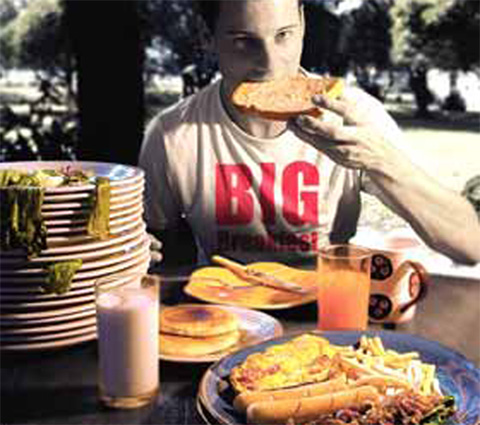My neighbor on the first floor had left out a big bowl of candy for trick-or-treaters. I would tiptoe down the stairs, grab a handful and tiptoe back up. I would tell myself I’d had enough, but then I would end up tiptoeing back down yet again. I was unable to stop. I couldn’t control myself. I can so clearly remember the disgust I felt towards myself, lying in bed with all those little wrappers around me…
-Anonymous Overeater

This is just one of the many podcasts Angelina listens to every morning as she prepares for the day. One might wonder, why on Earth would someone listen to something so dour first thing in the morning? Aren’t mornings meant for sunshine and chirping along with the chickadees?
For some, maybe, but for women like Angelina (whose real name could not be disclosed) who are recovering from a debilitating compulsive eating disorder, normalcy is hard to come by.
We’ve all seen television shows or heard stories about “strange addictions” (seriously, who gets addicted to “aged urine baths”?), and as implausible as such things may seem, it is even harder to comprehend the addictive irony (if you will) regarding food, the root vital to survival.
“I once had a heroin addict say to me: ‘I don’t get it, I can eat a hamburger and just stop’,” Angelina said. “But with any addiction, whether it be food, drugs or alcohol, it’s all just a barometer of our spiritual fitness. Diseases don’t discriminate.”
As Angelina launched into the tale of her tumultuous relationship with food, I began to internally berate myself for a naïve conclusion I had drawn before meeting her: I had expected her to be fat. Actually, fat is too mild. I was preparing and (as horribly embarrassing as it is to admit now) almost hoping for her to be obese; and not the my-parents-fed-me-chocolate-bars-for-breakfast type of obese, but more along the lines of the “What’s Eating Gilbert Grape” variety.
But she was neither. Just the opposite, in fact – trim, amiable, attractive. Trying to stifle a blush, I confessed my preconceived thoughts, and told Angelina I was surprised by, well, how healthy she looked.
“I don’t look like I have an eating disorder,” Angelina said, pleasantly unsurprised by my assumptions (to my great relief). “At first I thought, well I’m skinny, and Overeaters Anonymous is for fat people. But you can’t judge people on appearances. Just because someone’s skinny, doesn’t mean they’re not sick.”
Although bodies with ribs prominent enough to substitute as xylophones are fawned over in our “sensational” version of the world, the unnaturalness of such a look indicates a rampant spread of diseases like anorexia, compulsive eating and in Angelina’s case, exercise bulimia.
“I would wake up, binge on breakfast, graze on snack foods, eat lunch, graze some more, binge on dinner, have two desserts, and then go to bed hating myself,” Angelina said. “The next day, I would have a banana, take three dance classes, have salad, and then run a mile.”
Even for an Olympic athlete, that degree of exercise and food intake is dangerously unhealthy. While more immediate diseases like alcoholism or excessive drug use can’t help being in the spotlight (Michael Jackson was the icing on the cake in terms of celebrity losses – well, for me at least) many may be unaware that, according to ANAD (National Association of Anorexia Nervosa and Associated Disorders) “eating disorders have the highest mortality rate of any mental disorder.”
Growing up in a metropolis of the dysfunctional, Angelina’s childhood struggled to even be subpar in an environment rife with abuse and chaos. After watching her parents divorce, her mother go to jail and living her adolescence out of a suitcase, Angelina “started using food to turn down the volume.”
“It took off the edge, helped me numb out,” Angelina explained. “In the end, I’m grateful I did overeat, because I was very depressed and probably would have killed myself if I hadn’t used food as a blanket.”
Noticing a progression in her compulsive eating habits – you know you’re in trouble when you’re binging on broccoli – Angelina said she realized how very little control over her life she had. Her days revolved around food (“What am I going to eat? What am I not going to eat? How am I going to get rid of it?”), and her maladjusted routine began to put a serious strain on her social life.
“I did it all,” Angelina admitted. “I ate frozen food, burnt food, food out of the trashcan, even food off of people’s plates when they went to the bathroom. It’s not a sexy disease. I couldn’t tell any of my friends or family because I didn’t want them looking at me while I ate or be scared to eat around me.”
Angelina eventually sought out help, attending OA meetings long drives away under false names for fear of being recognized or linked back to her home town. But merely being present at meetings wasn’t enough, and a point came where a combination of a rocky relationship with a drug addict (“When you’re sick, you’re attracted to other sick people,” she said) and zero control over what (and how much) she was eating, led her to hit what we all dread: rock bottom.

“One night, I was all alone and ate like 12 hot pockets and 15 ice cream sandwiches,” Angelina said numbly. “I thought, ‘I don’t want to live.’ I was going to OA, but I wasn’t doing the program – I was just crying and talking about food. I even failed at bulimia. I tried to throw up and I couldn’t. I would sit on the toilet for hours and hope it would just fall out. I felt totally insane.”
It was then that an altogether alarming conclusion came to her: “If I don’t get help, real help, I’m going to die.” Life or death is enough to motivate anyone (I would hope); Angelina got a sponsor, started attending three meetings a week and developed a flexible food plan. But as classical mechanics would have it (damn you, Newton!) an opposing reaction was bound to occur.
“They say when you put down the fork, you pick up something else,” Angelina said. “Even though I was doing better in OA, I noticed how bad my communication and codependency problems were. I also couldn’t stop shopping, and I started spending money in a very scary way.” (I didn’t give her too much flak regarding her latter statement – we are women, after all).
She was reminded by her sponsor about the pros and cons of “pulling a geographic” (we all know the cliché, or rather, truth of being unable to run from your problems), but Angelina was floundering in the western world (spending seven years with a drug addict will do that to you, I suppose).
“I couldn’t stay in America any longer,” Angelina said. “I heard Thailand was a very spiritual place, and I kind of wanted to “eat, pray, love it.’ Well, without the eating part.”
Angelina is now living in Chiang Mai teaching English, a far-cry from her 20-something mindset that was “fuelled by shitty, narcissistic thoughts.” It’s been seven years with OA, and though she is finally able to laugh at her “culinary indiscretions,” the (altogether now!) compulsive overeater, exercise bulimic, compulsive shopper, underearner, codependent, al-non and love addict (as she jokingly signed an email to me) is still adjusting to living a life of recovery in a developing country.
“Coming from New York, I’ve went from the Rolls Royce of OA meetings to the tuk-tuk,” Angelina said with a laugh. “In Chiang Mai, there’s only one OA meeting, and it just started. I’m not sure how the Thai culture feels about addiction and eating disorders, but it’s been very hard to get help here.”
The only meeting available so far in Chiang Mai is at McCormick Hospital in Building 11, and is held on Saturdays from 4-5 pm. Although Thailand has a lot to offer in terms of rehabilitation – The Cabin in Chiang Mai is known to be one of the best (but unfortunately, the most expensive) drug treatment facilities in Asia – more specific addiction centers such as OA are difficult to find.
“In the States, if I didn’t like a meeting, I could just go to a different one,” Angelina said. “In Thailand, I can’t do that. I’m also one of the only women at the meetings, which is odd, because back home it’s the other way around.”
That’s no surprise seeing Angelina comes from a country where roughly ten million women suffer from eating disorders. Although, according to ANAD, approximately 43 percent of women are able to obtain treatment, one has to wonder where someone needing help can turn to in a city like Chiang Mai, which while flourishing, only houses one OA meeting. But Angelina is looking at her new home (for now) from a healthy perspective, and hopes to serve as a pioneer for those needing help.
“The old-timers from back home stepped up for me, and now I need to step up and help as many people as I can here,” Angelina said. “I want to do other things, I don’t want to be so obsessed with my recovery. There are dips in life, times you are going to feel uncomfortable (and it’s very uncomfortable feeling uncomfortable), but you can’t fill those dips with food, alcohol, sex, gambling, cluttering, or whatever it is.”
If you are unsure if you have an eating disorder or are thinking of seeking counsel regarding an addiction, you can namelessly (as proclaimed) or openly attend any anonymous meeting (which are also available through Skype). For more information, please refer directly to the OA website http://www.overeatersanonymous.org.